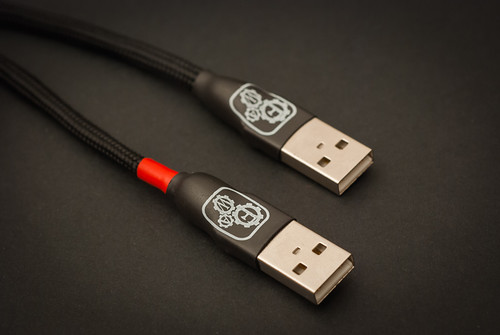Here I am reviewing a special copper Twin USB cable made by Forza Audioworks (Poland). The Twin USB cable was thought with the main goal of separating the power and signal lines, in order to keep the power constant and help the USB clock’s stability.
Functionality and Technical principles
While certain cables draw both power and signal from a single usb, and then split the two lines (by spiralizing the two), the Twin cable has as main goal to separate power selection from the computer.
The computer is a source of EMI, RF and magnetic fields, which can easily interfer with both signal and power supply line, and add up to the jitter seen by the transport.
I have been trying the Twin cable with my Trent iCruizer battery (11000 mAh battery), which has a 5V usb output for power only.

Gear used
Audiophilleo 2, Zodiac Gold as transports/DAC’s; Museatex IDAT44m, MHDT Stockholm 2 as DAC’s. Headamp AE2, Stax SRM-727A as amplifiers. Audio Technica AD2000, Stax SR-X Mk3 Pro as headphones.
Sound
The Forza Audioworks Twin usb cable with battery power offers a consistent improvement over the Wireworld ultraviolet and the usb cable coming along with the Zodiac Gold. Such sonic improvement consists mainly in improved clarity in imaging: the spatial background becomes “blacker”, improving what I have defined as “clarity of sparks” and sense of drifting of the tiny details in the soundstage space.
The Audiophilleo 2 and the Zodiac Gold react differently in bass department, where the Audiophilleo reveals a stronger bass presence (similar to the AP1 with Pure Power), which is less noticeable with the Zodiac Gold, both used as usb DAC and as transport.
The Audiophilleo 2, in particular, gains similar characteristics to the AP1+PurePower, especially in the bass authority. The advantages are clearly listenable, although the “jump” isn’t equal as raising from a Stello U3 / ART Legato to an Audiophilleo 2.
Plugging the two inputs in separate USB sockets doesn’t sound as plugged in the battery. Still, the sound manages to be more resolving than using Wireworld Ultraviolet.
As an update (19/05/2013): I have compared it at a friend’s place, with his AMR DP-777, my amp and headphones, and his amp and headphones, against the Wireworld Starlight and the Acoustic Revive USB1.0-SP. The Forza Audioworks Twin Cable sounded better than the Starlight, managing to be more resolving and less digital sounding than such Wireworld. The Starlight is cleaner sounding than the Wireworld Ultraviolet, but also more digital sounding.
The Forza Audioworks Twin cable managed to stand its own a bit against the Acoustic Revive twin cable (which retails for a bit over 450 Euro), but the latter sounded overall noticeably better, offering a more musical presentation, a high level of transparency coupled with a natural sound, where, by comparison, the Forza Audioworks cable was adding a bit too much ‘air’ for obtaining the same level of resolution.

Conclusion
At its cost (around 110 Euro for a 2 metres unit), the Forza Audioworks Twin cable offers an advantage in both sound and functionality compared to other cables, with the ability to experiment with the low-noise, stable power offered by batteries.
I believe that even using different batteries is going to change the sound quality a bit: Bakoon’s or Kingrex Upower batteries, fore example, are more explicitly thought for audio, and they might be some interesting choices to experiment with.
While not as great sounding as the Acoustic Revive twin cable, the Forza manages to compete for a much lesser price tag. Paying 110 Euro for the Forza Audioworks or over 350 Euro more than that amount, for an Acoustic Revive USB cable, can make or not make sense depending on the budget of a person, the overall cost of an audio system, and the impact that such usb cable will do in the given system.



